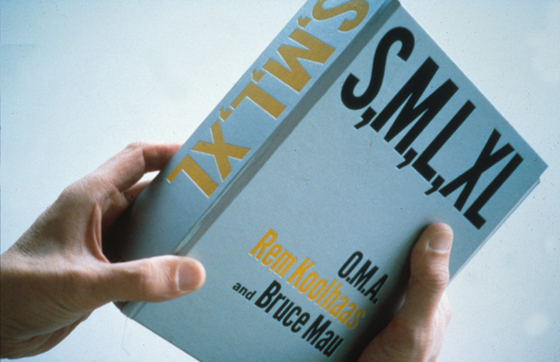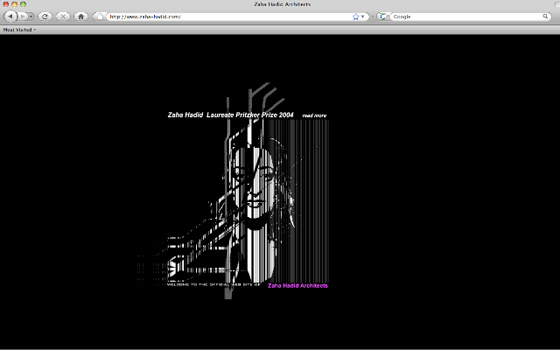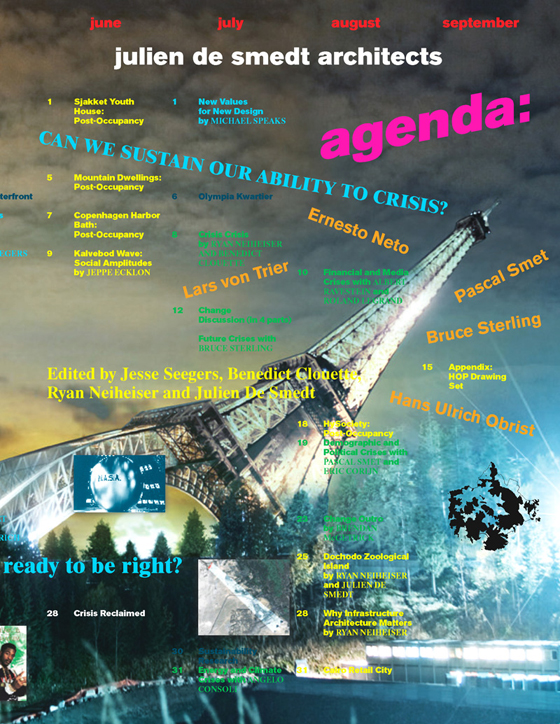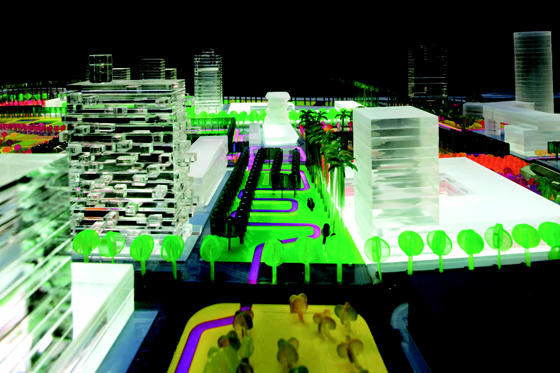Look Who's Talking: architecture in the global-communication era
Texto por Alexander Horne
Oslo, Noruega
16.06.10
If architecture is the accumulation of centuries of knowledge, then what of its existence in an era of perpetual and instantaneous updates that the Internet and social networking brings? For a technology-driven industry, it seems slow to embrace the possibilities of continuous information exchange. A number of young studios appear to have some answers, which in the process of challenging dusty perceptions are 'Twittering' and marketing their names to the forefront of architecture today ahead of the starchitects of yesterday.
'We sell intelligence, not architecture.' A bold statement, not solely applicable to its source, Oslo-based practice Space Group, but something of a general way of working for a number of architecture studios in terms of the fresh approach they take to their work and the way they are perceived in the public domain. Space Group's roster of staff reads like anything but a bunch of architects (featuring, among others, industrial and graphic designers, and film-makers) and is testament to their holistic vision, one based on trading a full intelligence package as opposed to a single iconic architectural monument.
Screenshot of Oslo-based practice Space Group's homepage, where news and other information takes precedence over project images; www.spacegroup.no
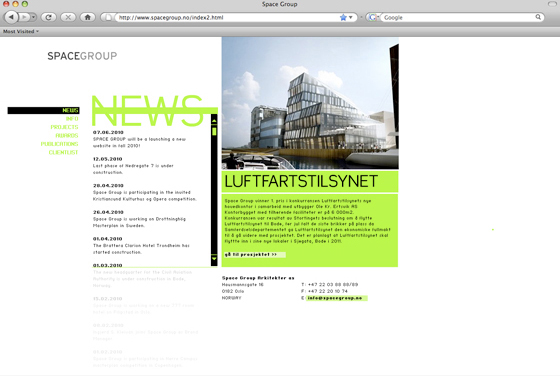
Screenshot of Oslo-based practice Space Group's homepage, where news and other information takes precedence over project images; www.spacegroup.no
×It's a vision shared by other practices du jour, such as Vicente Guallart in Spain, JDS in Denmark and Fantastic Norway. While an all-encompassing take on architecture is nothing new, it is the manner in which knowledge is distributed by these studios that stands out as significantly different. From blog-style websites to attention-grabbing public acts and warts-and-all publications – the conventions of traditional architectural communication are being given a shake up in wake of the 'starchitect'. Originally published in 1995, Rem Koolhaas and Bruce Mau's 'S,M,L,XL' was, as well a contemporary bible of architecture, the start of this re-consideration of communication.
Cover of 'S,M,L,XL' by OMA, published by Monacelli Press (New York, 1995)
Prior to the book, discovering architects' innermost thoughts or learning about a project's details often entailed wading through lengthy academic texts and image-led coffee-table books. What 'S,M,L,XL' offered was a universally understandable peek inside architecture's chassis. In today's global context, though, even this 3-kilogram treasure of diary excerpts, travelogues, essays and more is often over our travel weigh allowance. Perhaps this is part of the reason why those on the move now source and exchange information online.
In light of Vicente Guallart's view that 'our generation is the first to operate in a global context', it would be expected that 'his generation' would have a significant online presence. How far back the generation he is talking about goes though is debatable. Having a quick browse through the websites of two of the architects who have established themselves as brand architecture's biggest names over the past 20 years – Zaha Hadid and Frank Gehry – the difference between their online face and that of JDS or Vicente Guallart is stark. If you manage to navigate past Zaha's flickering portrait, the next challenge is finding your way through the awkward pitch-black mapping of her works. Oh, and good luck finding out what the studio is about.
Screenshot of Zaha Hadid's homepage, where confused navigation reigns; www.zaha-hadid.com
Frank Gehry's website is even less generous and seems to stop dead on the homepage. This is by no means, of course, a reflection of their actual architectural work – Gehry and Hadid were and still are important figureheads. However, when compared to the easy-to-navigate and communicative sites of Guallart, JDS and Space Group, you could argue that they do not need the general public or online community to know about their work or they way they work. Perhaps they think it better to leave it to the critics to write about this.
From those studios who have a more communicative online presence: Space Group's homepage dictates that you read their news first; Guallart treats blog, background and books in the same way as projects; while JDS is most emblematic of the blog generation through its listing of text, punctuated with bright, fluoro highlighting. It seems the three studios want visitors to know they can write and communicate as well as complete thought-provoking and functional projects. Gone is a showcase of nicely photographed works and in its place a dynamic communication portal, building brand relationships with potential clients and the media.
'Fantastic Caravan' project in Oslo by Fantastic Norway; photo Dagbladet
Moving away from the computer screen, Oslo-based Fantastic Norway has been gaining wider attention through a number of offline activities akin to the work of the Peter Cook-led Archigram movement. Although they have only actually completed a small number of large-scale projects, their name has become known to the extent that they regularly cross the Atlantic to conduct lectures at leading architecture schools and recently featured in the introduction of the historical tome 'Made In Norway'.
'Fantastic Caravan' project in Moscow by Fantastic Norway
Fanastic Norway first garnered attention through the Buckminster Fuller-esque act of towing a bright-red caravan, which housed an exhibition, to the 2008 Venice Biennale, with the aim of 're-establishing the architect as an active participant of society'. Their stock seems set to rise even more with a forthcoming architecture-themed television series, backed by Norway's leading network NRK – thankfully not completely inspired by the UK's Kevin McCloud, presenter of British TV series 'Grand Designs' and the much replicated idea of people building their dream homes from scratch. If Fantastic Norway is to follow in the footsteps of one of the first groups of architects to use television as a platform to reach a wider audience – a Danish series of ‘architecture battles’ that included Bjarke Ingels of Big amongst others – then perhaps next on their project list is an open-source diary available from all good bookshops.
Cover of 'Agenda' by JDS, published by Actar (Barcelona and New York, 2009)
Recent publications by practices such as Big and JDS are not merely books to gawp at but, rather, examples or teasers of the knowledge and vision they are proposing to sell. Julien de Smedt's 'Agenda', published by Actar, is a full-on, tell-all diary of the office's work and life through the recent downturn. The book is an unusual but refreshing format for the usually pristine and buttoned-up world of architecture publications. The thought processes are apparent throughout the stories of failed projects, frustrating clients and genuine breakthroughs. Ideas, emotions, sketches and models are there for all to see. There is, however, no flashy photography of finished buildings or uniform presentations of plans and sections, suggesting that the value is in the process and not necessarily the final forms. Vicente Guallart's 'Geo Logics' book by the same publisher delves deeper into a polymath approach to projects, cross-referencing information from sociology, geology, engineering and economics in relation to structures. 'The buildings that we construct today and the cities we inhabit are the products of an accumulation of knowledge over the course of our history,' states Guallart. Perhaps this is why he wants people to know that his practice has that knowledge available. Guallart's Socioplos project, an innovative housing project for urban and environmental development and shared habitat, is a fine example of his self proclaimed cross-fertilization of knowledge, taking into consideration aspects as varied as disability allowance and urban farming. If the multifaceted nature of the book's content appears too heavy, you can always have a look at the project model – a brightly coloured maze of forms that are more like sweet shop than architecture.
'Sociopolis Model 2' by Vicente Guallart; image Guallart Architects
Design theorist John Thackara remarked that 'in the Stern Review of Climate Change Economics publication, for the first time a mainstream economist questioned the sense of perpetually accelerating growth and productivity as success criteria.' If the suggestion that knowledge and process should merit the same, if not more, value than actual production, then the concept of open-sourcing knowledge and methodology is a smart move by the aforementioned studios. The holistic view of architecture ¬¬– valuing intelligence and space, as opposed to just a building – which the communication activities of such architects as JDS, Space Group and Gullart speak of, would seem to be an appropriate response to such changes, where value is measured through more than just a glossy magazine spread.
As a sharp reminder, however, that knowledge does not always equal value, it is interesting to note the words of a structural engineer from Arup, Rory McGrath, who, with over 20 years' experience of working on large-scale projects with such practices as OMA, agrees that architects require a wider knowledge. However, 'the question is how to use these parameters to obtain additional design value.'

